SPR Instruments
This page is a round-up of the SPR intstruments currently available. The instruments differ in their way of using the technology and design of bringing the interactants in contact which each other. For a direct jump to the manufacturer, click on the logo's in the text. This list is by no means complete.
Let me know about the instruments which should be listed here by contacting the sprpages.
Are you a vendor and do you want to be listed on the sprpages, please use the following document.
 Plasmetrix Inc. is a Canadian company headquartered in Quebec, specializing in the development, manufacturing, and global distribution of proprietary SPR and LSPR instruments for biomedical applications and microscopy. We focus on portable and ultra-portable platforms that combine robust performance and sensitivity with exceptional value. Serving universities, research institutes, and biotechnology companies, Plasmetrix helps teams accelerate discovery with practical, cost-effective plasmonic solutions and provides ideal tools for the next generation of point-of-care (POC) devices.
Plasmetrix Inc. is a Canadian company headquartered in Quebec, specializing in the development, manufacturing, and global distribution of proprietary SPR and LSPR instruments for biomedical applications and microscopy. We focus on portable and ultra-portable platforms that combine robust performance and sensitivity with exceptional value. Serving universities, research institutes, and biotechnology companies, Plasmetrix helps teams accelerate discovery with practical, cost-effective plasmonic solutions and provides ideal tools for the next generation of point-of-care (POC) devices.
Why Plasmetrix?
- Portable & modular: field-friendly size without sacrificing core performance
- Low operating cost: standard thin-gold chips; simple, serviceable fluidics
- Flexible workflows: quick reconfiguration from flow-cell to cuvette to petri dish
- Precision analytics: sub-nanometer LSPR peak-tracking; ~10-6 RIU in SPR
 Delta Life Science was founded in 2018 as a spin-off from TNO (Dutch organisation for applied scientific research). Delta's mission is to make multiplexed, label-free biosensing accessible to all. In June 2024 we launched our first instrument (inQuiQ™) aiming to improve the accessibility of label-free biosensing and accelerate life science research.
Delta Life Science was founded in 2018 as a spin-off from TNO (Dutch organisation for applied scientific research). Delta's mission is to make multiplexed, label-free biosensing accessible to all. In June 2024 we launched our first instrument (inQuiQ™) aiming to improve the accessibility of label-free biosensing and accelerate life science research.
With Delta's NES technology at its core, the inQuiQ™ instrument is to set to transform the landscape of biosensing. The inQuiQ™ allows scientists to conduct highly sensitive, multiplexed analysis with ease. The inQuiQ™ offers:
- 16-plex measurements: obtain more data points from a small sample on a reusable sensor
- Complex matrices: improved measurements in serum, plasma and supernatant due to the combination of a silicon chip and polycarboxylate hydrogel
- Compact design: the use of NES technology enables sophisticated analysis taking up limitid space (30 x 40 cm) on your lab bench
- Wide range of sample volumes: supports sample volume from 25 µL to 2 mL for diverse experimental needs
- Cost-effective solution: a premium instrument at an affordable price without compromising results
Take a look at the inQuiQ™ on our website and the video of the instrument launch.
Visit Delta Life Science Vysens developed a gradient system capable of determining kinetic constants and active analyte concentrations in the same run. The AutoVysion verstility makes it an essential tool across a wide range of (clinical) research and diagnostic applications. From screening incoming/outgoing antibodies, testing of coupling methods to antibodies, the determination of affinity or concentration of antibodies and testing of serum from patients; our technology is paving the way for efficiency improvement, for example in certain cases of ELISA testing, FACS testing and complicated SPR systems.
Vysens developed a gradient system capable of determining kinetic constants and active analyte concentrations in the same run. The AutoVysion verstility makes it an essential tool across a wide range of (clinical) research and diagnostic applications. From screening incoming/outgoing antibodies, testing of coupling methods to antibodies, the determination of affinity or concentration of antibodies and testing of serum from patients; our technology is paving the way for efficiency improvement, for example in certain cases of ELISA testing, FACS testing and complicated SPR systems.
 The SPR #64 is equipped with a rotatable 8-channel microfluidics therefore the instrument allows the read-out of up to 64 sensor spots simultaneously. In addition, the SPR+ detection technology ensures the wide application range, covering small molecules as well as therapeutic research. In total, up to 4 microtiter plates can be used within the autosampler unit and for long term experiments the instrument allows plate feeding with external robots. Next to the standard settings the instrument stands out by features such as Dual-Injection, Frame-Injection, two external reagent supplies as well as an 8-buffer panel, which boosts the assay development capabilities to an unachieved level.
The SPR #64 is equipped with a rotatable 8-channel microfluidics therefore the instrument allows the read-out of up to 64 sensor spots simultaneously. In addition, the SPR+ detection technology ensures the wide application range, covering small molecules as well as therapeutic research. In total, up to 4 microtiter plates can be used within the autosampler unit and for long term experiments the instrument allows plate feeding with external robots. Next to the standard settings the instrument stands out by features such as Dual-Injection, Frame-Injection, two external reagent supplies as well as an 8-buffer panel, which boosts the assay development capabilities to an unachieved level.
The user interaction in front of the instrument is dramatically reduced due to the usage of a dual prism consumable. This contains a cleaning prism (glass) as well as an active prism (gold + surface chemistry). Thus, after each experiment the instrument can be cleaned automatically without any user interaction.
Throughput and Sample Handling:
- Inject 8 samples simultaneously from plates with either 96- or 384-wells
- 30k+ interactions per 24 hours
- Inject samples from plates, the reagent notch or reagent troughs
- Robotic integration for additional samples (optional)
- Integration into scheduling software via it´s API
At right the schematic illustration of rotatable 8-channel microfluidics. Per injection direction, either horizontal or vertical, 64 sensor spots as well as 72 interspots will be addressed with sample solution.
The Sierra SPR-32/24 Pro analytical instrument is a high-throughput, high-performance, real-time, label-free (RT-LF) analysis system. It has all features expected from a high-throughput system, including 8 flow cells with either 4 or 3 detection spots for a total of either 32 or 24 individually addressable sensors, robust microfluidic sample delivery and high sensitivity SPR+ detection. The Sierra SPR-32/24 Pro utilizes Hydrodynamic Isolation™ (HI) technology to deliver high-throughput sample analysis with dedicated in-line controls.
Key features and specifications for the Sierra SPR-32/24 Pro system are summarized below:
- Simultaneously inject 8 samples from 96- or 384-well plates
- 4400+ (SPR-24 Pro), 3300+ (SPR-32) samples with dedicated controls, ~8,800-10,000+ interactions per 24 hours
- Inject samples from plates, tubes or reagent troughs
- Robotic integration for additional samples (optional)
- Integration into scheduling software via it´s API
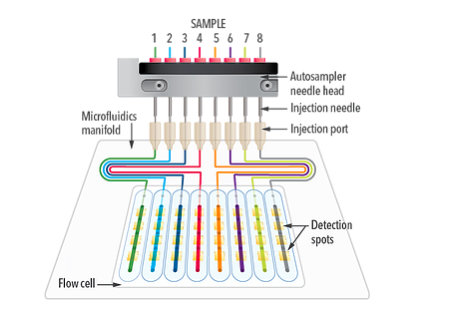
- Detection
- Unique SPR+ detection
- Optimized signal-to-noise for small molecule, fragment and low concentration binding
- Observe dose-dependent binding from 0 – 2 RU
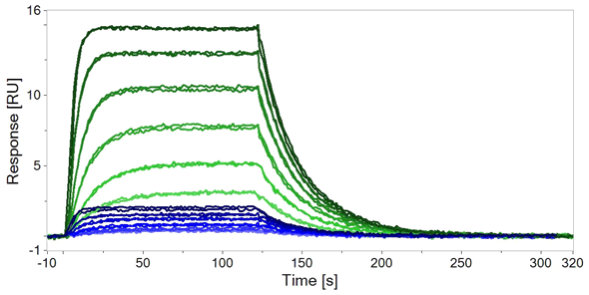
- Sensors and Buffers
- Up to 32 different surfaces per sensor
- Multi-buffer exchange of up to 4 buffers (2 flow channels per buffer, in pairs)
- A different assay on each flow channel
- Liquid Handling
- Continuous flow microfluidics for kinetic analysis
- Proprietary Hydrodynamic Isolation™ for sample delivery
- Rapid transitions between flow buffer and samples
- No mechanical microvalves
- Quick and automated user maintenance routines
- Use complex sample & buffer matrices without clogging
- Software
- Straightforward drag-and-drop interface
- Fully automated assay templates or on-the-fly control
- Batch or single sensorgram viewing and data analysis
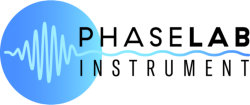
The Ipso-LAB 2Ch from PHASELAB Instrument is a 2-channel SPR instrument which is compact, accessible, and practical. It is capable of precise and stable measurements, thanks to a unique and patented system for the measurement of the angular variation of the intensity and phase of the SPR signal. Microfluidic cells of about 10µL with different possible configurations, with 1 or 2 channels are used. The results are presented in real time to the user in a simple RU (Response Unit) graph that can easily be exported to further SPR treatment tools. PHASELAB Instrument

iMSPR series are iClubio's SPR devices developed to be applied to all research fields.
iMSPR-mini: This is a compact 2-channel entry-level model. Users can easily enter the SPR field through this model. You can monitor the entire process from image processing for SPR curve acquisition to sensorgram acquisition, and it is a model that can evaluate yes/no, ranking, affinity and rough kinetics. It is the best choice for academic practice, teaching and basic research.
iMSPR-Pro: This is a semi-automated 2-channel professional model that integrates a degasser, a 2-channel control valve, and a manual sample injector that can perform accurate kinetics evaluation. This device can be used as a fully automated device when combined with an automatic sample injection device. It is the best choice for basic research in pharmaceutical and biotechnology labs.
iMSPR-ProX: iMSPR-ProX model is a fully automatic SPR system with auto sampler. This device is not simply equipped with an autosampler, but if you prepare a sample to be analyzed in the autosampler, the device also derives kinetic evaluation results. This is a true sample-to-answer system. ProX can install two 96-well plates at a time, enabling large-capacity screening of candidate drugs, which is the initial stage of new drug development. Now you can dedicate your analysis to the fully automated ProX and spend your time doing more important things that are more important to you.
iMSPR-Lab: This is a multifunctional model that can process a variety of samples (gas to liquid). The central incidence angle can be adjusted up to 40-80 degrees, so it can be used for surface studies, and various organic solvents can be applied, making it suitable for chemical experiments. In addition, it can measure gas, making it the best choice for researchers developing gas sensors.
Visit iCLUEBiO The P4SPR is a unique portable, 4-channel SPR instrument that delivers high-performance measuring and monitoring data of specific targets in complex media such as drugs or disease biomarkers (e.g. antibodies, antigen, hormones) in blood serum or toxic chemicals (e.g. microorganism toxins, industrial organic compounds) in underground waters. The P4SPR's accessible price makes it an attractive label-free system for academic research and startup labs performing assay optimization, system characterization or routine monitoring of proteins and chemicals in lysate, blood, milk or simple buffer. Also, the P4SPR's open architecture makes it easy to combine with other analytical methods such as spectroscopy, chromatography and mass spectrometry to fit your specific needs.
The P4SPR is a unique portable, 4-channel SPR instrument that delivers high-performance measuring and monitoring data of specific targets in complex media such as drugs or disease biomarkers (e.g. antibodies, antigen, hormones) in blood serum or toxic chemicals (e.g. microorganism toxins, industrial organic compounds) in underground waters. The P4SPR's accessible price makes it an attractive label-free system for academic research and startup labs performing assay optimization, system characterization or routine monitoring of proteins and chemicals in lysate, blood, milk or simple buffer. Also, the P4SPR's open architecture makes it easy to combine with other analytical methods such as spectroscopy, chromatography and mass spectrometry to fit your specific needs.

![]() The Sartorius Pioneer systems can characterize a wide range of interactions with high quality kinetic data (ka, kd) and affinity measurements (KD). Although based on traditional SPR, Pioneer systems incorporate OneStep injection technology. Here a compound solution is diffused into a moving stream of buffer to create a concentration gradient during the injection. As such, a single analyte injection is sufficient to measure kinetic and affinity values accurately. In contrast to traditional fixed concentration injections (FCI), OneStep provides better resolved kinetic traces compared to square-shaped traces due to the generation of a continuous concentration gradient 3–4 orders of magnitude during the OneStep process. Pioneer systems provide rapid affinity data directly from primary screens, significantly reducing the time and cost associated with secondary screening while enabling the prompt identification of lead candidates.
The Sartorius Pioneer systems can characterize a wide range of interactions with high quality kinetic data (ka, kd) and affinity measurements (KD). Although based on traditional SPR, Pioneer systems incorporate OneStep injection technology. Here a compound solution is diffused into a moving stream of buffer to create a concentration gradient during the injection. As such, a single analyte injection is sufficient to measure kinetic and affinity values accurately. In contrast to traditional fixed concentration injections (FCI), OneStep provides better resolved kinetic traces compared to square-shaped traces due to the generation of a continuous concentration gradient 3–4 orders of magnitude during the OneStep process. Pioneer systems provide rapid affinity data directly from primary screens, significantly reducing the time and cost associated with secondary screening while enabling the prompt identification of lead candidates.
Pioneer System
The Pioneer SPR systems combine the accuracy and sensitivity of traditional SPR analysis with the benefits of a robust design, simpler assay setup, shorter run times, reduced sample consumption, and higher throughput. Pioneer instruments precisely deliver analyte sample to the SPR flow cell in a continuous concentration gradient using an innovative sample dispersion and delivery system. A wide range of concentrations is covered in a single injection, eliminating the need to run multiple dilutions of sample to obtain accurate kinetic and affinity constants. The injection technology saves time and sample material, reduces the variance introduced by pipetting multiple samples and target immobilization among different channels and improves analysis of unstable targets which need to be tested quickly before all activity is lost.
Pioneer FE System
This system is ideal for screenings in fragment-based drug discovery (FBDD). Using the basics of the Pioneer, the Pioneer FE system has a higher sensitivity and incorporates NeXtStep Injection technology which diffuses two different samples against each other in a crossed sigmoidal profile. NeXtStep methods employ multiple assay formats to determine competition mechanisms or inhibition concentrations (IC50) in a single injection. There is no need for a sample dilution series as the NeXtStep gradient measures a wide concentration range encompassing all concentrations necessary for analysis.Sartorius webpage
![]() Xantec markets a two and four channel SPR-system form Reichert. At the end of 2018, Xantec significantly expanded the possibilities of SPR with the SPR-PLUS system, based on Reichert's 2-channel SPR platform. The focus of this concept is not so much on classical SPR measurement but on the use of the technology as a highly sensitive detector that can be used for miniaturization of chromatographic approaches or for preparative SPR analysis. Application examples and additional modules can be found at Xantec webpage
Xantec markets a two and four channel SPR-system form Reichert. At the end of 2018, Xantec significantly expanded the possibilities of SPR with the SPR-PLUS system, based on Reichert's 2-channel SPR platform. The focus of this concept is not so much on classical SPR measurement but on the use of the technology as a highly sensitive detector that can be used for miniaturization of chromatographic approaches or for preparative SPR analysis. Application examples and additional modules can be found at Xantec webpage
 Carterra® is a leading provider of innovative technologies designed to accelerate the discovery of novel therapeutic candidates. Carterra’s high throughput LSA" instrument for monoclonal antibody (mAb) discovery and characterization combines patented microfluidics technology with real-time array Surface Plasmon Resonance (SPR) and industry leading data analysis and visualization software, delivering up to 100 times the throughput in 10% of the time while using only 1% of the sample compared to existing platforms. The LSA provides customers with mAb characterization throughput and functionality that matches the output from state-of-the-art antibody expression platforms. This enables all antibodies to be rapidly and comprehensively screened early in the discovery process so that unique epitopes and potential novel therapeutic candidates can be identified, while expanding and enhancing IP coverage. Visit Carterra
Carterra® is a leading provider of innovative technologies designed to accelerate the discovery of novel therapeutic candidates. Carterra’s high throughput LSA" instrument for monoclonal antibody (mAb) discovery and characterization combines patented microfluidics technology with real-time array Surface Plasmon Resonance (SPR) and industry leading data analysis and visualization software, delivering up to 100 times the throughput in 10% of the time while using only 1% of the sample compared to existing platforms. The LSA provides customers with mAb characterization throughput and functionality that matches the output from state-of-the-art antibody expression platforms. This enables all antibodies to be rapidly and comprehensively screened early in the discovery process so that unique epitopes and potential novel therapeutic candidates can be identified, while expanding and enhancing IP coverage. Visit Carterra
 Alto is the world's first SPR instrument to integrate digital microfluidics (DMF), artificial intelligence (AI), and nanotechnology to provide high quality, label-free interaction analysis. DMF technology enables all fluidics to be disposable, allowing for precise handling of @lt;2uL sample volumes, crude sample compatibility and zero maintenance. Alto's compatibility with automation for both hardware and software provides sample-in/answer-out data, industry-leading throughput, and 24/7 runtime. Every aspect of Alto is designed with user-friendliness and accessibility in mind - from the flexible 16 channel design to the intuitive data analysis platform.
Alto is the world's first SPR instrument to integrate digital microfluidics (DMF), artificial intelligence (AI), and nanotechnology to provide high quality, label-free interaction analysis. DMF technology enables all fluidics to be disposable, allowing for precise handling of @lt;2uL sample volumes, crude sample compatibility and zero maintenance. Alto's compatibility with automation for both hardware and software provides sample-in/answer-out data, industry-leading throughput, and 24/7 runtime. Every aspect of Alto is designed with user-friendliness and accessibility in mind - from the flexible 16 channel design to the intuitive data analysis platform.
Alto is capable of supporting operation in GXP and 21 CFR Part 11 in compliance with regulatory demands.
OpenSPR-XT is a fully automated molecular analysis instrument based on the highly successful OpenSPR instrument.
OpenSPR is a revolutionary surface plasmon resonance instrument that provides powerful label-free analysis while being the most affordable and compact instrument on the market. Instead of using the traditional gold films for the sensor chip, OpenSPR utilizes highly sensitive gold nanoparticles to give detailed information on nanoscale surface interactions. OpenSPR can be used for many SPR applications including binding affinity, kinetics, detection, surface chemistry and more. It is intuitive, easy to use, and compatible with proteins, antibodies, DNA, peptides, polymers, small molecules, and more. OpenSPR’s unique design also allows it to double as a visible cuvette based spectrophotometer.
 BioNavis Ltd manufactures Multi-Parametric Surface Plasmon Resonance instruments that provide high content information on molecular binding, but also at the same time on nanolayer and nanoparticle properties. Apart from kinetic constants and affinities, thanks to a multiwavelength scanning setup, also conformation changes can be resolved using LayerSolver. PureKinetics™ (pat.pend.) allows measurements of bulk effect directly in the measurement channel providing clean sensograms without bulk artifacts even in 100% serum or 5% DMSO. The MP-SPR Navi™ instruments can be used for traditional SPR applications and moreover also in material sciences.
BioNavis Ltd manufactures Multi-Parametric Surface Plasmon Resonance instruments that provide high content information on molecular binding, but also at the same time on nanolayer and nanoparticle properties. Apart from kinetic constants and affinities, thanks to a multiwavelength scanning setup, also conformation changes can be resolved using LayerSolver. PureKinetics™ (pat.pend.) allows measurements of bulk effect directly in the measurement channel providing clean sensograms without bulk artifacts even in 100% serum or 5% DMSO. The MP-SPR Navi™ instruments can be used for traditional SPR applications and moreover also in material sciences.
The applications include:
(Bio)pharmaceuticals – drug-target, drug-lipid and also drug-living cell interactions, antibody characterization, controlled drug release, nanoparticle drug delivery, small molecules, measurements in 100% serum.
Biosensors – developing assays directly on final material – cellulose for printed biosensors, metal for amperometric and potentiometric sensors, polymers for well-plates, metal nanoparticles for SERS, graphene, CNTs… with crude samples including sea water, saliva, plasma and others.
Biomaterials – MP-SPR measures molecular interactions on even 15 microns thick polymers.
BioNavis Ltd manufactures Multi-Parametric Surface Plasmon Resonance instruments that provide high content information on molecular binding, but also at the same time on nanolayer and nanoparticle properties. Apart from kinetic constants and affinities, thanks to a multiwavelength scanning setup, also conformation changes can be resolved using LayerSolver. PureKinetics™ (pat.pend.) allows measurements of bulk effect directly in the measurement channel providing clean sensograms without bulk artifacts even in 100% serum or 5% DMSO. The MP-SPR Navi™ instruments can be used for traditional SPR applications and moreover also in material sciences.
Thin solid films – Barrier coating development for solar cells, antibacterial coatings, moisture barrier, gas sensors using graphene, ceramics, metals and more… measurements of thickness and refractive index down to 3.7 Ångströms (graphene monolayer).
Currently, there are four models in the MP-SPR Navi" family:
- Semi-automated 200 OTSO
- 6-sample automation 210A VASA
- 2-channel 220A NAALI with well-plate automation
- 4-channel 420A ILVES with KineticTitration and 96-well-plate for fast runs
The instruments come with PureKinetic" feature that measures bulk effect in-line and allows for even 5% changes in DMSO concentration during run or measurements in 100% serum, providing premium quality kinetics data.
LayerSolver" is a software module allowing quantification of true thickness and refractive index based on a unique scanning multiwavelength measurement.
The instruments use an elastomer-coated prism which ensures easy handling of sensors (no need for refractive index oil or gold-coated prisms) and also enables storage of the sensors for future experiments, re-use or validation ex-situ.
There is a wide range of optional flow-cells including combinations with electrochemistry, fluorescence or measurements in harsh liquids. The flow-cells can be easily exchanged with a single button push.
 With the industry’s highest sensitivity combined with the broadest sample compatibility, our WAVE instruments offer a whole new level of previously unattainable interaction data. Our instruments are praised for their performance, ease of use, and robustness. Our latest addition, the WAVEdelta, offers:
With the industry’s highest sensitivity combined with the broadest sample compatibility, our WAVE instruments offer a whole new level of previously unattainable interaction data. Our instruments are praised for their performance, ease of use, and robustness. Our latest addition, the WAVEdelta, offers:
- Best in class sensitivity (0.01 pg/mm2) for measuring even the smallest interactions
- Most robust fluidics enabling measurement of crude samples such as membrane preps, virus-like particles, liposomes or even undiluted blood serum or plasma
- Parallel injections over four channels (or any combination thereof), and flow rates up to 400 µl/min for best referencing and measurement of fastest off-rates (up to 5 s-1)
- Built-in degasser and automatic switching between four buffers, and a measurement temperature range from 4°C - 45°C
- Very fast and stable temperature adjustments for thermodynamic measurements
- Full walk-away automation, and convenient wizards for immobilization, kinetics or screens
- Flexible, easy-to-learn software enabling full control over the experiment and access to raw data
- Built-in data evaluation with different pre-defined or user-defined kinetic models and report point plots
- One-click report generator for fast generation of electronic or paper lab books and publications
 Biosesing Instrument supplies innovative and high performance label-free molecular interaction analysis instruments based on Surface Plasmon Resonance (SPR). BI SPR instruments are used in the applications of life sciences, drug discovery, antibody characterization, biosensors and electrochemistry for the measurement of affinity and kinetics of small biomolecules and cell membrane, protein-protein or protein-antibody interactions and biomolecule concentration measurements.
Biosesing Instrument supplies innovative and high performance label-free molecular interaction analysis instruments based on Surface Plasmon Resonance (SPR). BI SPR instruments are used in the applications of life sciences, drug discovery, antibody characterization, biosensors and electrochemistry for the measurement of affinity and kinetics of small biomolecules and cell membrane, protein-protein or protein-antibody interactions and biomolecule concentration measurements.
SPRm 200 is the world’s first commercial SPR Microscopy. The system seamlessly integrates optical imaging and SPR technology and it enables label-free in vitro measurement of binding activity and kinetics of membrane proteins.
BI-4500, a R&D 100 Award winner as one of the most significant technology inventions in 2016, is a 5-channel series SPR equipped with BI-DirectFlow™ technology, which enables precision sample delivery with near-zero dispersion for higher-quality results, ideal for the study of ultra-fast kinetic interactions such as those in DNA sequencing, protein-protein interactions, ligand-receptor recognition, and drug development applications. System has wide dynamic range for both large and small molecules (≤ 100 Daltons) and low baseline noise.
BI-2500 is a 3-channel series SPR ideal for biosensor or material science applications. The system’s modular approach allows SPR studies combined with electrochemistry or gas sensing applications. Anodic stripping analyses and studies on electropolymerization, redox-related conformational change, gas chemical sensor research, and fundamental solid-gas interface studies are some applications performed with this equipment.
 Our devices can be standalone or integrated into other systems such as optical microscopes, fluorescence and Raman systems. Being miniature these devices can be positioned under a microscope or a spectrometer to probe both concentration, refractive index, fluorescence, Raman, surface shape or other spectroscopic signals. The present version of the PhotonicSys SPR system can record sensograms with detection limit down to 10-6 refractive index units (RIU) in a user friendly graphical interface (see below). The device has a size of 4.5"x4.5"x8.5" and a weight of 1.9 kg.
Our devices can be standalone or integrated into other systems such as optical microscopes, fluorescence and Raman systems. Being miniature these devices can be positioned under a microscope or a spectrometer to probe both concentration, refractive index, fluorescence, Raman, surface shape or other spectroscopic signals. The present version of the PhotonicSys SPR system can record sensograms with detection limit down to 10-6 refractive index units (RIU) in a user friendly graphical interface (see below). The device has a size of 4.5"x4.5"x8.5" and a weight of 1.9 kg.
Our plasmonic substrates vary depending on the type of the sensing required and maybe sold separately.
PhotonicSys Surface Plasmon Resonance Sensors:
Surface waves are waves propagating along the interface of two different media. They can be gravity waves such as at the surface between two fluids with different densities, elastic waves such as seismic waves (Rayleigh or Love waves) or electromagnetic (light waves) between two media having two different optical properties. One of the intriguing phenomena occurring at the interface of metals and dielectric media is surface plasmon resonance (SPR) wave. This wave maybe described as a collective oscillation of the free electrons Fermi gas at the metal surface. Its excitation requires light with wavelength incident at an angle such that its momentum along the interface is high enough to match that of the surface plasmon wave.
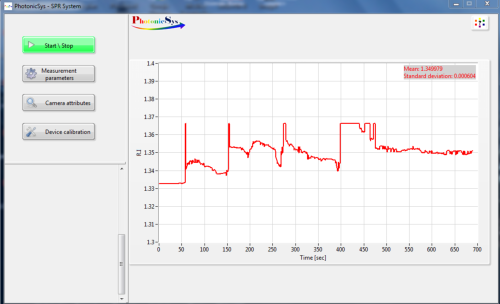
 The NanoSPR8 481 is a eight channel Electrochemical Surface Plasmon Resonance Spectrometer capable of performing real time biokinetic, immunosensing and biosensing measurements.
The NanoSPR8 481 is a eight channel Electrochemical Surface Plasmon Resonance Spectrometer capable of performing real time biokinetic, immunosensing and biosensing measurements.
- 8 channel measurements (for elimination of the drift one or two channels can be is used as a reference)
- open architecture (allows easy access to Au chip, optical setup customizations)
- thermo-stabilization box and thermo-heating in cell available
- possibility of electrochemical measurements (external potentiostat is required)
- 4 measurement modes: single full curve, multiple curves, tracking and slope mode
- measurements in air and liquid environments
- full SPR curve during measurements (can be used for fitting)
- inexpensive 20 x 20 mm Au chips, ability to evaporate your own chips
- software integration with peristaltic pump
 The IBIS MX96 applies SPR imaging with scanning angle optics. The large dynamic and linear range allows label free measurements to be ranging from less than 1 Resonance Unit (RU) up to 30.000 RU with noise levels of 0.2 RU RMSD. The imaging platform facilitates real-time sensing of analyte interactions in combination with the Continuous Flow Microspotter (CFM) of Wasatch Microfluidics (Salt lake city, Utah US) on a 6x8, 4x12 or an 8x12 CFM array of ligands.
The IBIS MX96 applies SPR imaging with scanning angle optics. The large dynamic and linear range allows label free measurements to be ranging from less than 1 Resonance Unit (RU) up to 30.000 RU with noise levels of 0.2 RU RMSD. The imaging platform facilitates real-time sensing of analyte interactions in combination with the Continuous Flow Microspotter (CFM) of Wasatch Microfluidics (Salt lake city, Utah US) on a 6x8, 4x12 or an 8x12 CFM array of ligands.
Strong feature of the IBIS MX96 is the possibility to apply unlimited exposure times of samples for very low limits of detection. Its valve-less injection of samples and "back-and-forth" flow-based fluidics enables to inject only 70 microliter sample volumes which can be recaptured. The unsurpassed multiplexing capacity of this platform provides scope to use various surface chemistries including 3D (gel-type) and 2D (planar) chemistries on SensEye® sensors.
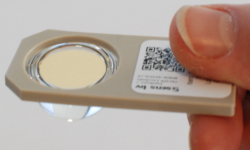
An analysis cycle of 96 samples of 70 microliters in combination with analysis of a 48 spot microarray, generates > 5000 referenced sensorgrams of unattended operation in a single run. The SPRintX software has been developed to measure biomolecular interactions in such an organized way that kinetic evaluation of the analysis is straightforward. It enables the user to measure high content screening assays without coming into an uncontrolled mess of data which cannot be processed conveniently. The instrument competes with the other instruments in the high-end label free sensing market. It has been sold to various pharmaceutical companies, biotech and research institutes.
Visit IBIS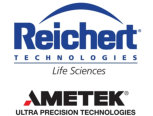 Reichert Technologies - Life Sciences introduces the new Reichert4SPR, 4 Channel Surface Plasmon Resonance system for label-free, real time investigation of biomolecular interactions. Sensitivity and baseline stability make the Reichert4SPR the ideal instrument for both macromolecular and small molecule kinetic or concentration determination experiments. The Reichert4SPR has four channels and is targeted on the typical industrial Biacore T200 user. The four channels can be run with three experimental channels and one reference or with two experimental channels with separate reference.
Reichert Technologies - Life Sciences introduces the new Reichert4SPR, 4 Channel Surface Plasmon Resonance system for label-free, real time investigation of biomolecular interactions. Sensitivity and baseline stability make the Reichert4SPR the ideal instrument for both macromolecular and small molecule kinetic or concentration determination experiments. The Reichert4SPR has four channels and is targeted on the typical industrial Biacore T200 user. The four channels can be run with three experimental channels and one reference or with two experimental channels with separate reference.
With a low noise (+/- 0.05 µRIU RMS) and low drift (0.1 µRIU min-1) the instrument is perfect for small molecules or low concentrations of large molecules.
Drag and drop injection, dissociation and regeneration methods make setting up run tables fast and easy. Loop functions simplify repetitive operations on up to 768 samples.
| Technical Specifications: Reichert4SPR | |
|---|---|
| Measurement channels | 4 |
| Sample loading | Autosampler - up to 768 samples |
| Temperature range | 10°C below ambient to 70°C |
| Degassing unit | Built in |
| Flow rate range | 0.1-250 µL/min |
| 21 CFR Part 11 compliance | Compliant |
| Sample volume | 5-5000 µL (depends on loop volume) |
| Refractive index Resolution | < 10⁻⁸ RU |
| Refractive index range | 1.33 – 1.40 (@780 nm) |
| Analyte concentration range | 1 mM – 1 pM |
| Minimum molecular weight detection | < 100 Daltons |
| Drift | 0.1 µRIU/min |
| Baseline noise | 0.05 µRU RMS |

Reichert SR7500DC Dual Channel Surface Plasmon Resonance System.
Reichert's SR7500DC pushes the limits of detection and sensitivity in label-free interaction analysis.
The SR7500DC Dual Channel System is the next generation of surface plasmon resonance (SPR) technology with incomparable sensitivity and high-quality binding data for interaction analysis - all in a flexible component-based platform. The key to the system is the advanced SR7500 Dual Channel SPR Spectrometer instrument.
The SR7500DC label-free system generates data on critical interactions between proteins, nucleic acids, lipids, carbohydrates, small molecules, whole cells, bacteria, viruses, and polymers.
The SR7500DC System is used in pharmaceuticals, drug discovery, antibody screening, protein structure and function, gene regulation, and systems biology. Exceptional sensitivity in the SR7500DC System provides real-time data and is ideal for:
- High quality kinetic analysis
- Affinity measurements ranging from 1 mM to 1 pM
- Precise determination of thermodynamic parameters
- Accurate concentration analysis